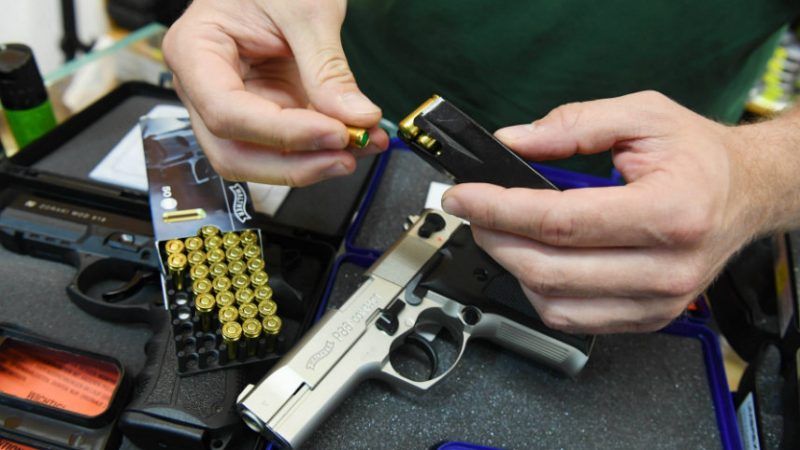Civilians Around the World Become Better Armed
Will widespread private arms rebalance power between individuals and the state? It looks like we're going to find out.


A note to the folks obsessed with somehow disarming all civilians: You may want to find a new hobby. This particular horse isn't just out of the barn, it's in the field shooting skeet.
Worldwide, there are about 857 million firearms in civilian hands—up 32 percent from the last Small Arms Survey estimates in 2006. For comparison, there are about 133 million firearms controlled by the world's militaries and 22.7 million in the hands of law enforcement across the planet.
That means a growing numbers of civilians around the world are in a position to push back against police and militaries that serve often-abusive governments, and that are already outmatched in terms of raw weaponry. In the wake of the murderous, state-sponsored horrors of the 20th century, this latest report from the respected, Geneva-based Small Arms Survey represents good news to many people (albeit not the usual suspects you'll see quoted on the news).
The disparity in arms between government forces and civilians is common in much of the world, but particularly dramatic in the United States, which accounts for a huge share (about 46 percent) of the world's privately held arms.
In the U.S., which has seen a sharp decline in violent crime over the past quarter-century (from 747.1 violent crimes per 100,000 residents in 1993 to 386.3 violent crimes per 100,000 residents in 2016), law enforcement officers wield an estimated 1,016,000 firearms and police a civilian population that owns 393,300,000 firearms. Even the U.S. military adds only another 4,500,000 firearms to the equation (not counting heavy weapons).
Civilians in the U.S., as elsewhere, aren't getting any less well-armed relative to their political masters, either.
"Civilian ownership appears to be growing globally," notes the Small Arms Survey. "In the United States alone civilians acquired at least 122 million new or imported firearms during the period 2006–17."
As the U.S. data shows, well-armed civilians aren't necessarily dangerous civilians.
"[T]he countries with the highest level of firearm violence—they don't rank high in terms of ownership per person," said Anna Alvazzi del Frate, the Small Arms Survey's program director. "So what we see is that there is no direct correlation at the global level between firearm ownership and violence."
But which civilians own guns? Is ownership widespread? Or is it a shrinking pool of fetishists withering away until two guys in Idaho end up sitting on massive personal armories?
"Three-in-ten American adults say they currently own a gun," Pew Research reported in 2017, and another 11 percent "say they don't personally own a gun but live with someone who does."
Forty-seven percent of households reported owning a gun in an NBC News/Wall Street Journal survey released last March.
Those figures are both somewhat at odds with the 2016 survey finding guns in 36 percent of households, leading to The Washington Post headline: "American gun ownership drops to lowest in nearly 40 years."
The problem, said the author of the Small Arms Survey report, Old Dominion University's Aaron Karp, is that "The lowest estimates of civilian ownership are often from surveys. If expert estimates can appear to exaggerate figures, surveys are sometimes suspected of underreporting… In the United States, for example, there is a growing trend among gun owners to refuse to answer surveys on firearm possession."
It turns out that if you vilify an activity and target it with official efforts at suppression, people engaged in that activity become reticent to discuss the matter. Who could have guessed?
No doubt with such concerns in mind, the Small Arms Survey carefully distances itself from policy recommendations based on its data. "We don't advocate disarmament. We are not against guns," Small Arms Survey director Eric Berman emphasized.
Which is just as well, considering what an uphill slog disarmament would be anywhere on the planet. That's especially true given that civilians acquire firearms not just from commercial sources that might be subject to regulation, but also from their own efforts. "Craft guns represent a major source of uncertainty in estimating global civilian firearms possession," the report notes.
By "craft guns," the report refers to anything from crudely made muzzle-loaders to AR-15s finished from 80 percent receivers. How many weapons fall into that category is unknown, but India alone estimates "annual production of roughly 2.5 million craft guns." A separate Small Arms Survey report examines Nigeria's vibrant craft gun culture, which also ranges in sophistication from muzzle-loaders to assault rifles.
And none of this takes into account technological revolutions in machinery and 3D printing—developments which recently led the authors of a RAND Corporation report to conclude that governments are losing the ability to control "risky goods such as firearms and drones." They predict that the pervasiveness of such technology "will further relax this control, giving private citizens greater access to lethal weapons and other tools of violence."
Despite the high-decibel shouting over the rights and wrongs of private gun ownership, civilians are pretty well armed around the world and becoming increasingly so as time goes on. Will that rebalance power between individuals and the state? It looks like we're going to find out.


Show Comments (85)